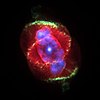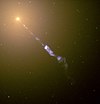Portal:Physics/2005 Selected articles
| This page is an archive. Do not edit the contents of this page. Please direct any additional comments to the current main page. |
This is an archive of entries that appeared on Portal:Physics's Selected Article section in 2005.
March 27, 2005 - Roche limit

The Roche limit is the distance within which a celestial body held together only by its own gravity will disintegrate due to a second celestial body's tidal forces exceeding the first body's gravitational self-attraction. Inside the Roche limit, orbiting material will tend to disperse and form rings, while outside the limit, material will tend to coalesce. The term is named after Édouard Roche, the French astronomer who first discovered this theoretical limit in 1848.
The Roche limit should not be confused with the concept of the Roche lobe which is also named after Édouard Roche and which describes the limits at which an object which is in orbit around two other objects will be captured by one or the other.
June 19, 2005 - Cold fusion
Cold fusion is the name for a nuclear fusion reaction that occurs well below the temperature required for thermonuclear reactions — such reactions may occur near room temperature and atmospheric pressure, and even in a relatively small experiment. The term was coined by Dr. Paul Palmer of Brigham Young University in 1986 in an investigation of the possible existence of fusion in a planetary core. It was brought into popular consciousness by the controversy surrounding the Fleischmann-Pons experiment in 1989. Unfortunately, no "cold" fusion experiments that gave an otherwise unexplainable net release of energy have so far been reproducible.
August 20, 2005 - Black hole
A black hole is a theoretical concentration of mass with a gravitational field so strong that its escape velocity exceeds the speed of light. This implies that nothing, not even light, can escape its gravity, hence the word "black". The term "black hole" is widespread, even though the theory does not refer to any hole in the usual sense. According to classical general relativity, no matter or information can flow from the interior of a black hole to an outside observer, although quantum mechanics may allow deviations from this strict rule. The existence of black holes in the universe is well-supported both theoretically and by astronomical observation; however, a minority of physicists dissent.
October 28, 2005 - Planetary nebula

A planetary nebula is an astronomical object consisting of a glowing shell of gas and plasma formed by certain types of stars at the end of their lives. They are in fact unrelated to planets; the name originates from a supposed similarity in appearance to giant planets. They are a short-lived phenomenon, lasting a few tens of thousands of years, compared to a typical stellar lifetime of several billion years. About 1,500 are known to exist in our galaxy.
Planetary nebulae are important objects in astronomy because they play a crucial role in the chemical evolution of the galaxy, returning material to the interstellar medium which has been enriched in heavy elements and other products of nucleosynthesis (such as carbon, nitrogen, oxygen and calcium). In other galaxies, planetary nebulae may be the only objects observable enough to yield useful information about chemical abundances.
In recent years, Hubble Space Telescope images have revealed many planetary nebulae to have extremely complex and varied morphologies. About a fifth are roughly spherical, but the majority are not spherically symmetric. The mechanisms which produce such a wide variety of shapes and features are not yet well understood, but binary central stars, stellar winds and magnetic fields may all play a role.

